Here I am in September 2017 when I began the Gokhale Method—sitting and bending over:
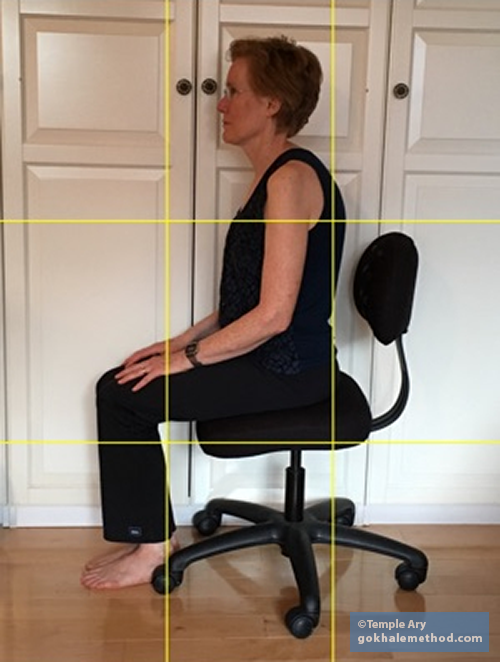
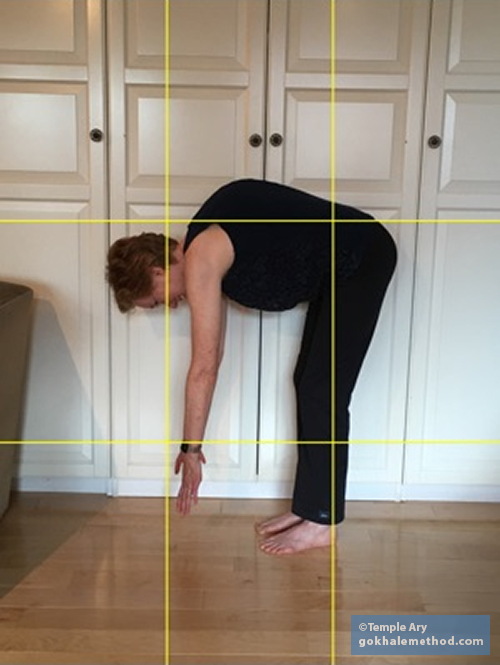
I have kyphosis. My upper back is curved from the shoulders to the bottom of my ribcage. The exact cause of my kyphosis is not known. There are two types of kyphosis: Scheuermann’s and postural. In Scheuermann’s disease, the normal bone growth in the vertebrae is interrupted during adolescence leading the spine to develop wedge-shaped vertebrae which result in a rounded curve in the thoracic spine. I believe I may have been diagnosed with Scheuermann’s Kyphosis at some point, but I don’t know for sure. I would like to think of it as postural because that word opens up more room for change.
I was born with my left leg and foot turned inward. I wore several different braces on my leg and my foot until the age of five. I became a shy and inhibited child, and I remember not wanting to be seen.
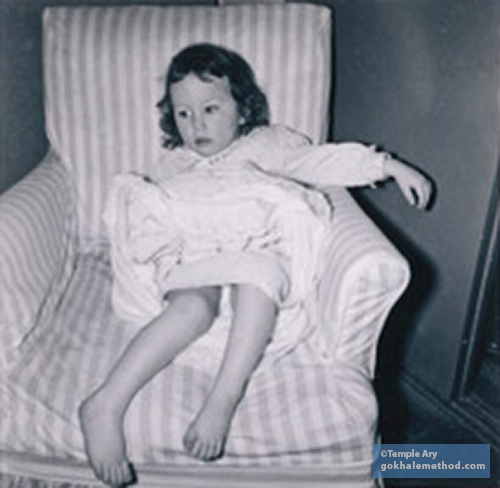
Me aged three and a half
Even as a young child, the outward curve of my upper back was already accentuated, perhaps to protect my inward self, which withdrew in anxiety and insecurity.

Even as a young child, I remember being fearful.
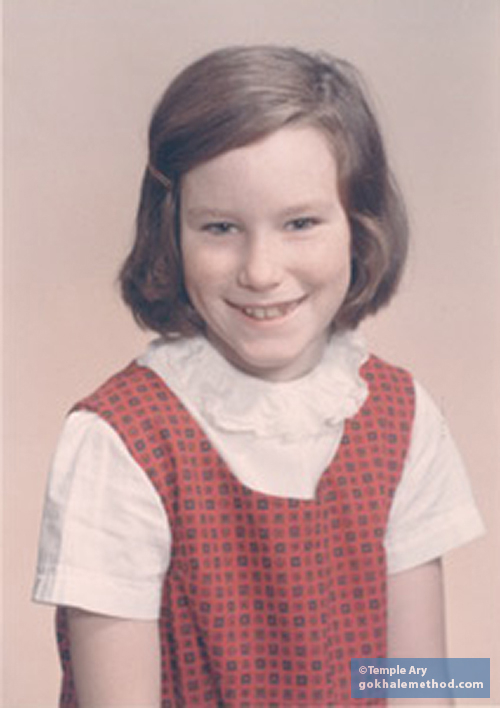
By 2nd grade, my shoulders were already turning in—and my chest too.
During adolescence I was constantly told to stand up straight. If I tried to pull myself up from my hunched position, my back muscles would fatigue and I would inevitably return to slouching.
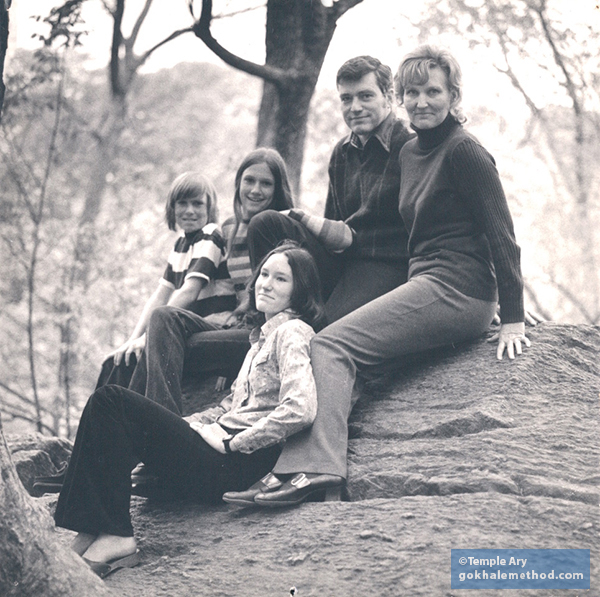
I remember this photoshoot vividly. (I am center.) I felt really ugly and sad at age 15. I felt uncomfortable in whatever I wore. I did not want to be in the picture. The photographer took lots of photos. Over the years, friends and family have remarked about how sad I looked. Every picture taken that day captured the shame that was locked inside of me.
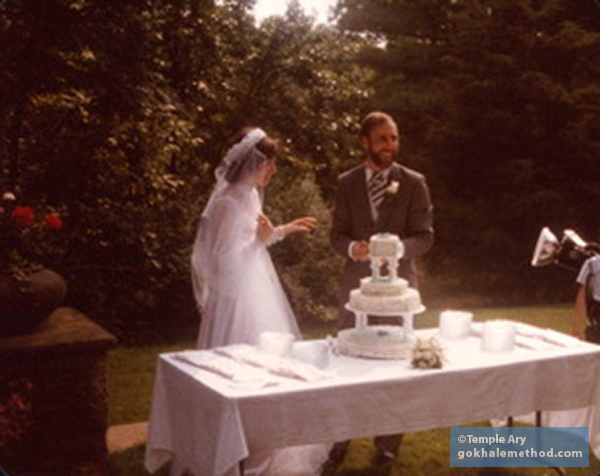
My marriage ceremony (age 26) to my husband David. I am pretty hunched over even on this occasion.
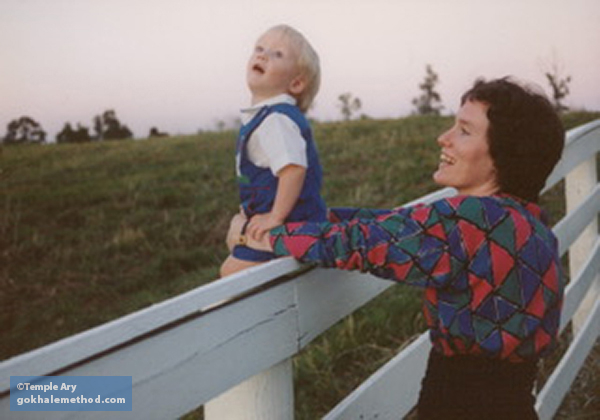
My son Charlie and me (age 32) in Kentucky. My curved back is really evident.
Fortunately, pregnancy, nursing, and motherhood did not seem to worsen my kyphosis. I had some pains, but the joy of motherhood eclipsed these. I set up a “nursing chair” for myself with lots of supportive pillows.
Pains then began to establish themselves in parts of my upper back, and I was given exercise regimens on several occasions over the years to better my posture. I was in pain, but over the years I learned to live with it. At the age of 33, my husband encouraged me to see a specialist, who recommended a fusion operation—to correct my appearance and relieve my pain. I was tempted to choose this path to free me from the hunch in my back. After contacting people who had undergone this surgery, I discovered that some experienced more pain after the fusion than before, so my husband and I canceled the operation.
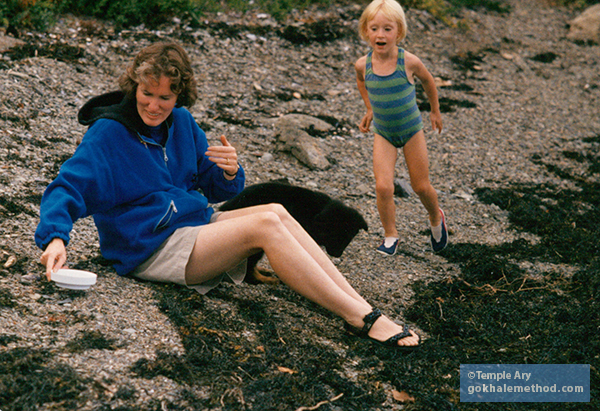
Here I am sitting in my usual hunched-over position, with my rounded upper body mirrored by my tucked pelvis. I am aged 38 here, with my daughter Katelyn.
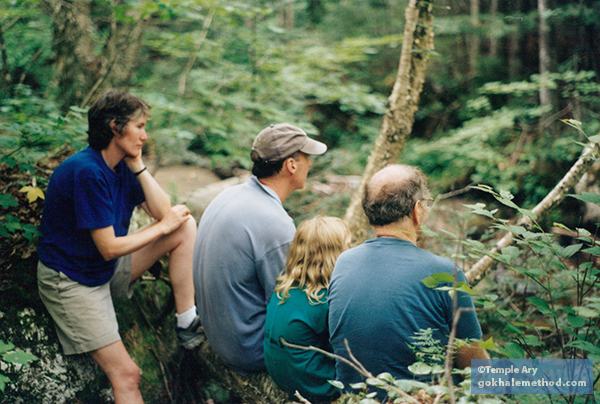
Here I am aged 46, with David, Katelyn, and our friend Leonard. My husband loved backpacking, but out of fear of hurting my back, I chose not to participate in many of the more adventuresome backpacking and canoeing activities that would have enriched our outdoor experiences.
Four years ago, at the age of 60, a good friend of mine encouraged me to investigate the Gokhale Method®. I attended a few free workshops, and then took the Foundations Course in New York City with Cynthia Rose. She gave me the hope I needed to begin my journey from being afraid, ashamed, and embarrassed about my physique to acceptance, appreciation, and discovery. I bought a Gokhale Method Stretchsit® Cushion, took two Alumni classes, scheduled some sessions of massage/acupuncture with Cynthia, purchased a used copy of Esther’s book, 8 Steps to a Pain-Free Back, and began to do the exercises on my own.
A year and a half ago, I received a Gokhale Method invitation to meet with Esther on the daily 1-2-3 Move online program. As I opened Zoom each day, I was fascinated by Esther’s broad knowledge base and her ability to hone specific skills. Her multicultural knowledge and research of traditional cultures gave her a worldwide perspective that drew on the wisdom of many traditions. Esther was unafraid of a difficult problem or question but would not be drawn into making predictions or entering territory that was outside of her expertise. She honored people’s differences and gave judicious hope. The hope Esther gave me was not just optimism that ignored the realities of my difficulties but was rooted in a deep respect and knowledge of the body and its structure.
Over time, I became part of a community of people committed to working together on our bodies and began asking questions myself. The camaraderie is immensely motivating. It makes a remarkable difference to know that Esther, or one of the other teachers, is online with me. A strong community has developed in this COVID-19 age of isolation.
Gokhale Fitness teacher Eric Fernandez answering my question on working my latissimus dorsi muscles.
I always look forward to my Gokhale Fitness session with Eric. It cracks me up that this strong, well-built young man truly enjoys our company! I love that he gives me ways to adapt each exercise to my level. His kind and relaxed manner gave me the courage to ask my first question. Aurelia answers questions with the most patient, comforting voice I have ever heard. And Kathleen and Roberta cultivate the beauty of silence and then slowly and gracefully explain each move of the Tai Chi sessions. I find the whole team of Gokhale Exercise teachers to be equally compassionate and committed to freeing others from pain and helping them take care of their bodies. Each program brings me a deeper understanding of the postural structure of my body.
Early in the Gokhale Exercise classes, I realized that I would benefit from some one-on-one sessions on how to walk, sit, and sleep. I needed both Esther and my husband to help me understand how I had been walking incorrectly for 62 years. My husband got excited about the glute work! I had hardly used my left glute and my left knee had never completely opened. With months of constant practice, I came to understand how to use my glutes and to open my knee.
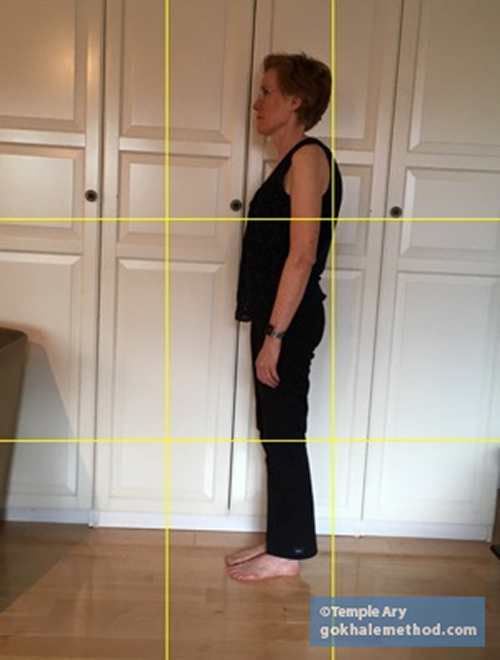
I had spent most of my life hunched and tucked when standing and walking.
I reached out to Esther again for a private session on how to sit healthily and adjust my desk to the correct height. I also attended an online workshop session on how to stretchlie.
This new-found body wisdom began to enter every aspect of my life, from walking down the stairs to sitting on the toilet. The Gokhale Method gives me a framework from which to evaluate and correct my posture in all activities. It keeps bringing me back to the core. Throughout the day I recall Esther’s words, “Are my ribs anchored? Are my shoulders rolled back? Is my head in the garage? Is my pelvis anteverted? Are my feet bean-shaped? Am I relaxed?”
But it is the dancing that unites everything! Esther showed me how to appreciate and move my body in a playful way. The beat of the music entices my muscles to work—and it’s fun! I have gone from being a person who felt awkward and ashamed of her body to one who feels rhythm and loves to create new dance movements.
How is my back now? I have kyphosis, yes, but my muscles are changing. I am so much more comfortable sitting at my desk. This is important because this is where I spend most of my hours.
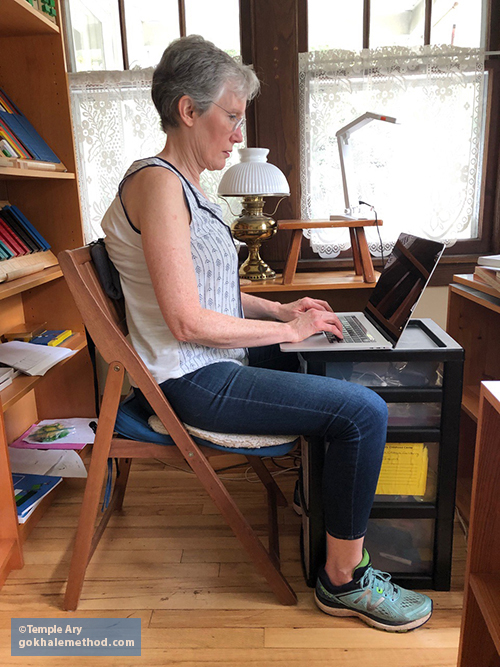
Sitting well at a laptop or desktop computer makes sitting comfortable in the moment and cultivates healthy posture. My shoulders are slowly returning to a healthier posterior position as my upper chest opens.
I continue to work on developing my gait in my regular daily walking and my glutes are definitely developing; I am able to identify my weak areas and work to strengthen them. The habitual pains have largely (but not totally) disappeared—and I know so much more about why I have them and can focus my work on the right places. When a particular exercise strikes me as personally beneficial, I incorporate it into my fifteen-minute morning and evening exercise routine.
A confidence permeates my mind and body. It replaces my shame and fears with the desire and energy for change. It enables me to choose what is good. A friend has remarked that my back looks straighter which confirms my inner knowledge that deep change is taking place. I am developing a patient contentment with the small incremental changes that are wrought through regular daily Gokhale Method instruction and my new life habits. There is much to be joyful over.
I write this with deep gratitude for the faithful dedication of Esther and her team.



Comments
Thank you for this blog! I
Thank you for this blog! I also have kyphosis which I developed at a young age.
May we get stronger and knowledgeable as we continue with the Gokhale method.
Lynn
Lynn - Let's learn together!
Lynn - Let's learn together!
I loved this blog. I have
I loved this blog. I have been doing the exercises online... off and on... for a few months. I fell recently and haven't been active, but am inspired by this blog to begin again.
Thank you!!
So glad that my story
So glad that my story inspired you. I am grateful to all at Gokahle for inspiring me!
Very moving Temple. Thanks
Very moving Temple. Thanks for sharing your story. I'm happy for your progress and glad you're part of our community each morning!
Great!!! Like a well none
Great!!! Like a well none brand says:
"never stop exploring"!
You're challenging yourself and pursuing the upgrade despite all!
Thank you, why your story is like fuel for me and the others human beings that want to explore beyond the phisical dimension, but having the necessity to do so through the phisical body!
Keep working! You're a champion at my eyes!
Awe thanks! We are champions
Awe thanks! We are champions together!
Wow Temple, great blog post.
Wow Temple, great blog post. It is so inspiring and you are looking great! Thanks for sharing all this with us.
The Gokhale Method emphasizes
The Gokhale Method emphasizes lengthening the spine Pokerogue and creating space between the vertebrae. This decompression technique helps in aligning the thoracic spine and counteracting the forward slump associated with a rounded upper back.